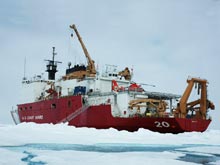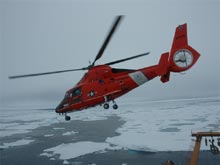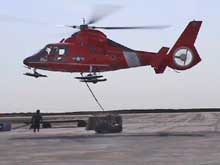
US Coast Guard Cutter HEALY operates with a compliment of two Coast Guard HH-65B Dolphin Helicopters in addition to Healy's normal equipment and crew. The Aviation Detachment (AVDET) is aboard Healy to assist with logistics, science support and other missions as requested by the command. Healy's current AVDET, AVDET 162 is the last in a long history of Coast Guard Aviation supporting Arctic science and research. Click image for larger view.
All personnel and scientific equipment for the cruise are brought aboard exclusively by helicopter. Exact numbers of people to be moved, equipment and baggage weights, numbers of boxes and contents are all listed and evaluated. As one aircraft drops off bags ashore, it picks up equipment and returns it to the ship. Both aircraft operate continuous trips until all personnel and equipment have been delivered. Click image for larger view.
Arctic Flyers; Science on Load
July 13, 2005
LT Kenneth Eller
Healy Helicopter Pilot
US Coast Guard Cutter Healy operates with a compliment of two Coast Guard HH-65B Dolphin Helicopters in addition to Healy's normal equipment and crew. The aircraft are operated and supported by four pilots and four flight mechanics. This grouping of people and machines are known on board as the AVDET, or Aviation Detachment. The AVDET is aboard Healy to assist with logistics, science support and other missions as requested by the command. Healy's current AVDET, AVDET 162 is the last in a long history of Coast Guard Aviation supporting Arctic science and research.
Coast Guard Cutter Healy's current mission, Arctic Summer East West 2005 (ASEW05), poses a new challenge to its AVDET. All personnel and scientific equipment for the cruise are brought aboard exclusively by helicopter. The ports in Northern Alaska are still blocked by thick sea ice and are completely unusable so air becomes the only option. So what does this mean and what does an "air on load" operation look like?
An air science on load is something like an aerial ballet performed in quick time. It's fast, complicated, somewhat risky and very well planned. The planning begins weeks prior to the mission being flown. Exact numbers of people to be moved, equipment and baggage weights, numbers of boxes and contents are all listed and evaluated. Calculation of what can be moved best at what times are all checked and rechecked. The AVDET's plan is presented to the Captain of the Healy and he OKs the final plan. The flying begins early with equipment and baggage being moved first. There are no one way trips. As one aircraft drops off bags ashore, it picks up equipment and returns it to the ship. Both aircraft operate continuous trips until all personnel and equipment have been delivered.
Vertical Replenishment (VERTREP) entails flying cargo nets full of equipment suspended below the helicopter. Pilots will position the helicopter low over the flight deck while a trained crewman runs underneath and hooks up the prepared load to a cargo hook attached to the helicopter. The load can then be carefully lifted and delivered anywhere the pilot desires. Click image for larger view.
The helicopters will refuel on board the ship without shutting down the engines, conserving valuable time, in an operation known as a "Hot Refuel." A rescue man stands by in a fire-retardant suit known as a "proximity suit," prepared to pull people out of the helicopter in case of a crash on deck. Click image for larger view.
The helicopters will refuel on board the ship without shutting down the engines, conserving valuable time. This operation is known as a "Hot Refuel." Vertical Replenishment (VERTREP) is the most efficient means of moving large amounts of equipment. This operation entails flying cargo nets full of equipment suspended below the helicopter. Slightly more complicated, VERTREP allows oversized items that do not fit within the helicopter to be moved safely between areas. Pilots will position the helicopter low over the flight deck while a trained crewman runs underneath and hooks up the prepared load to a cargo hook attached to the helicopter. The load can then be carefully lifted and delivered anywhere the pilot desires. Crewman must take care not to touch the helicopter as static electricity generated by the aircraft in cold air has the potential to deliver a significant shock. Special lines are attached to the load in order to discharge any stray voltage protecting crewmen from dangerous static electricity.
Weather is a factor the AVDET gives great attention to. Arctic weather does not change by the hour or even the minute; Weather in the extreme latitudes often follows the second hand. Fog, ice and wind conditions change very rapidly, making the northern reaches of the planet one of the most challenging places to operate aircraft. AVDET pilots exercise great caution examining weather forecasts, observed weather and local conditions prior to each flight. Visibility and icing conditions are particular concerns as AVDET aircraft operate primarily under Visual Meteorological Conditions (VMC) and ice adversely affects the flight characteristics of helicopters. In the end, if the weather is too bad, and the mission will allow, we opt to fly another day.
Challenging, exciting and adventurous all describe helicopter operations in the Arctic region. Coast Guard Cutter Healy and AVDET 162 are able to perform a vital service to the scientific community. As previously stated, AVDET 162 is the last Polar Operations AVDET to be deployed aboard Healy. The Polar Operations Unit has been disbanded due to fleet requirements and other units will soon carry the torch. AVDET 162 marks the end of a near forty-year history of The Polar Operations Unit operating in the Arctic. What a magnificent history it is.
Sign up for the Ocean Explorer E-mail Update List.



































